4 Ways Brands Can Gain Awareness on Clubhouse [+Examples]
If you’ve been on social media, marketing news sites, or the HubSpot Blog lately, you might have heard about Clubhouse.
The nearly one-year-old social media platform which allows users to drop into audio-only chat rooms has grown from 600,000 to 10 million active users in just a few short months. Although the app is invite-only, more and more people are gaining access and tuning into discussions related to their industry, hobbies, and other interests each day.
Users also love Clubhouse for its entertainment factor. When surfing through Clubhouse, you might find celebrities, like Joe Rogan, chatting with fellow influencers; audio-only musical productions, comedy nights; or even standup comedy events.
But, when exploring Clubhouse’s vast and highly-creative audio rooms as a marketer, you might wonder if and how you can leverage it within your marketing strategy.
At this point, most Clubhouse content is still highly experimental. However, one major theme to note is that it’s users want to hear from people — not just brands.
Because Clubhouse’s users crave authentic human discussion, they’ll likely disengage from rooms that prioritize promotional content over a relatable conversation.
However, while building brand awareness on an ultra-personal app like Clubhouse takes time, energy, and lots of community management, we’re already starting to see brands begin to connect with the channel’s growing audience.
To help marketers who are just learning about Clubhouse, I spent the last few days surfing the app to learn how brands are reaching users. Below I’ll highlight four common brand awareness tactics and offer a few actual examples.
How Brands Leverage Clubhouse
1. Fireside Chats or Q&As
When I first heard about Clubhouse and explored the app, a lot of rooms I dropped into felt like audio-only video calls or webinars where only the hosts began with speaking privileges. To me, it’s not surprising that brand-affiliated room creators and moderators have begun to leverage Q&As, panels, and fireside-chat formats to create interactive — yet well-managed — discussions on the platform.
When watching a panel or interview affiliated with a brand, it’s often formatted in one of two ways:
- The moderator — who works for the brand coordinating the room — asks thought leaders or influencers affiliated with their industry questions. This moderator might also permit audience members to ask questions or come to the stage to the speaker as well.
- An employee or leader from a brand serves as an interviewee or panel member while an influencer that does not work for the brand asks questions or moderates questions from the audience.
Regardless of which role the brand member holds in the chat, these rooms have very similar formats. They usually begin with the moderator announcing who they are, who they’ll be talking to, and the topic of the room. From there, the moderator will either ask questions to the speakers or giving speaking privileges to other users who raise their hands.
Below I’ll highlight two examples of rooms I’ve seen. Because Clubhouse is still invite-only and positioned as a safe space for communities to discuss thoughts, topics, or ideas, I will only note key parts of the conversations and room formats. I also did not record these rooms.
Below are two recent fireside chat examples:
Coinbase
A recent Clubhouse room, shown below, featured an interview with Coinbase Co-Founder and CEO Brian Armstrong. During the room, Sriram Krishman, a moderator from the club Good Time, asked Armstrong questions about how he got started in bitcoin and grew his company. They also discussed the future of cyber currency. Krishman, also invited listeners to raise their hands and ask questions to Armstrong to create more discussion around the complex cyber topic.
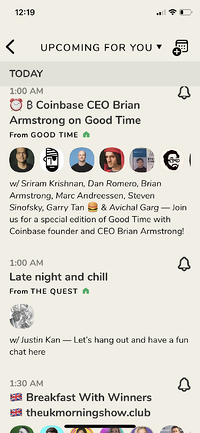
In rooms like the one above, users can learn more about a brand like Coinbase and ask its leader questions about the company or its industry. Through this experience, Coinbase and other brands could boost both company awareness and credibility with audiences who tune in to hear their canned, unedited discussion.
HubSpot
Recently, HubSpot also launched a fireside chat-styled room where our Chief Marketing Officer Kipp Bodnar, CTO and Co-Founder Dharmesh Shah, and Sr. VP of Marketing Kieran Flanagan invited prominent Clubhouse influencers including Bomani X to discuss “The Future of Marketing and Clubhouse.”
During the panel, Bodnar asked the Clubhouse influencers a few questions related to how they’ve grown their audiences on the platform; what they’ve done to optimize their profile, rooms, or clubs; and brand awareness etiquette. He also took similar questions or comments from a vast group of listeners including a weight-loss business founder, a scientist, and a Rubix cube enthusiast looking to build Clubhouse communities.
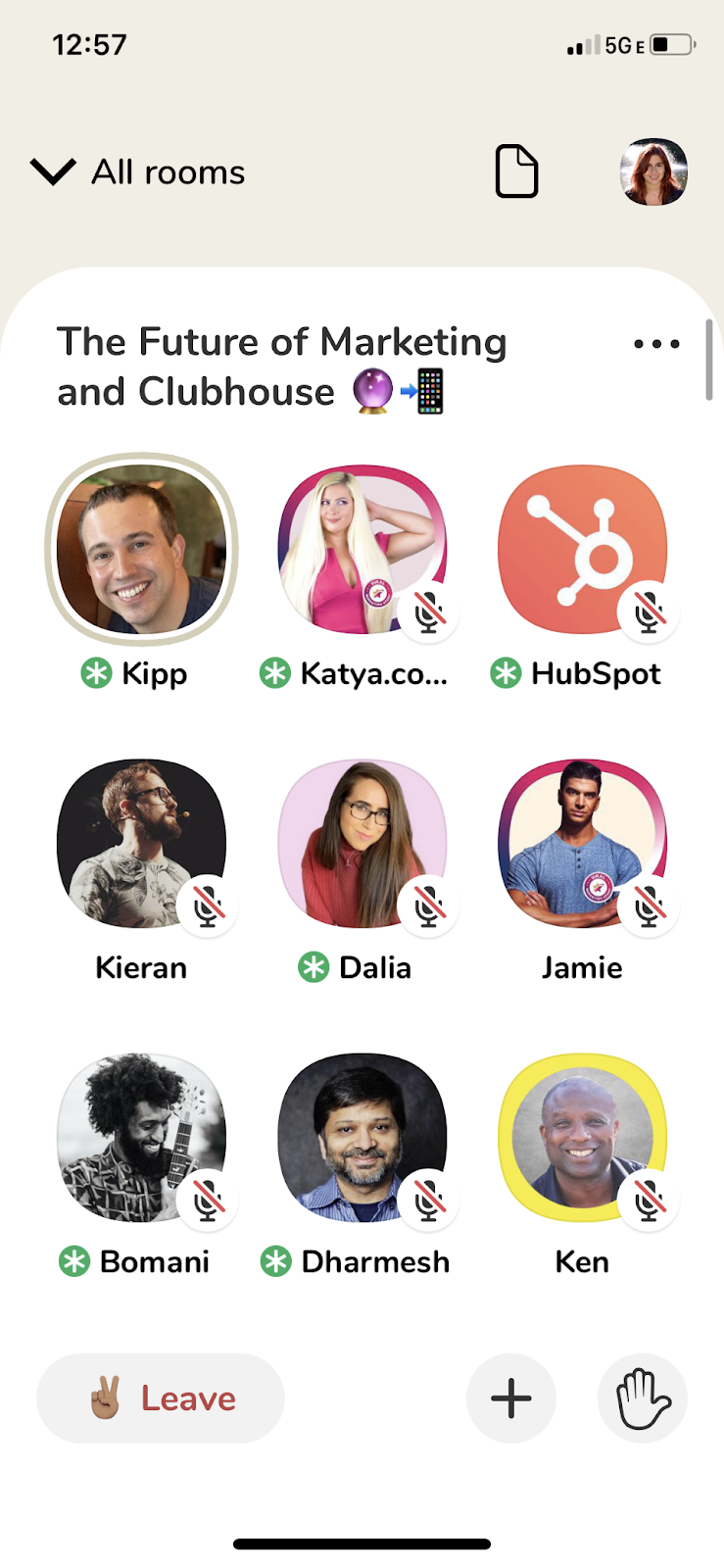
While HubSpot’s leaders haven’t claimed to be Clubhouse experts yet, they created a room to highlight what they know so far and connect listeners with some of Clubhouse’s high-profile early-adopters of the app with millions of followers. This is a great example of how the brand positions itself as a marketing thought leader even when they’re experimenting with a new, unique platform.
2. Sponsoring Room Events
While people might not want to join a room that discusses a product or brand positively the entire time, they might enter an interesting conversation or Clubhouse event that is sponsored by a brand.
When you drop into a sponsored room, you might not hear speakers from the brand speak much — or at all. However, when reintroducing the room, a speaker might mention that the room or Clubhouse audio experience is paid for or sponsored by the brand. You might also see a sponsor listed in the room’s title or description.
Below is one interesting example:
Yummy
Below is an example of a scheduled event sponsored by Yummy, a California-based grocery delivery app. During the room-based event — scheduled for June 5 — contestants will compete for a $100 Yummy gift card by performing an audio talent, such as singing or playing music.
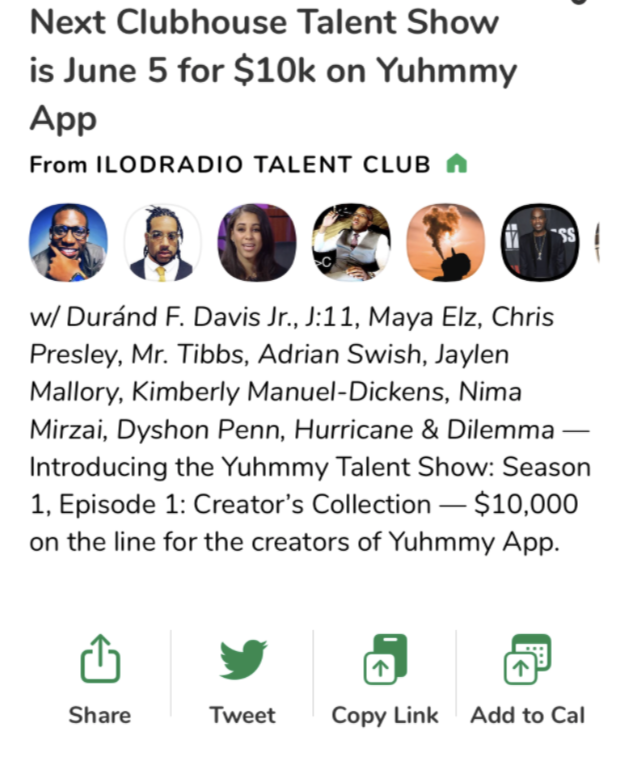
By sponsoring an experimental performance contest on Clubhouse, Yummy not only gets to see how creative Clubhouse content could benefit their brand, but they also promote their delivery service to a large pool of Clubhouse users who are interested in audio entertainment or music.
3. Having team members participate in rooms related to your industry.
Another way brands can grow awareness is by having chief officers, leaders, or even general employees raise their hands and actively participate by speaking in rooms with large audiences.
When speaking in a room, brand representatives don’t necessarily need to talk all about their company. However, by adding to a conversation, talking about tactics they’ve tried at their role, and showing off their expertise, audience members learn to trust them and their company. As company members gain a following and fanbase, their brand might also gain a new audience.
Below are two examples of brands that are embracing room participation.
Tax Nation LLC.
In a recent room titled “Marketing That Works in 2021 (so far)”, moderators asked listeners to raise their hands and offer their best marketing tips.
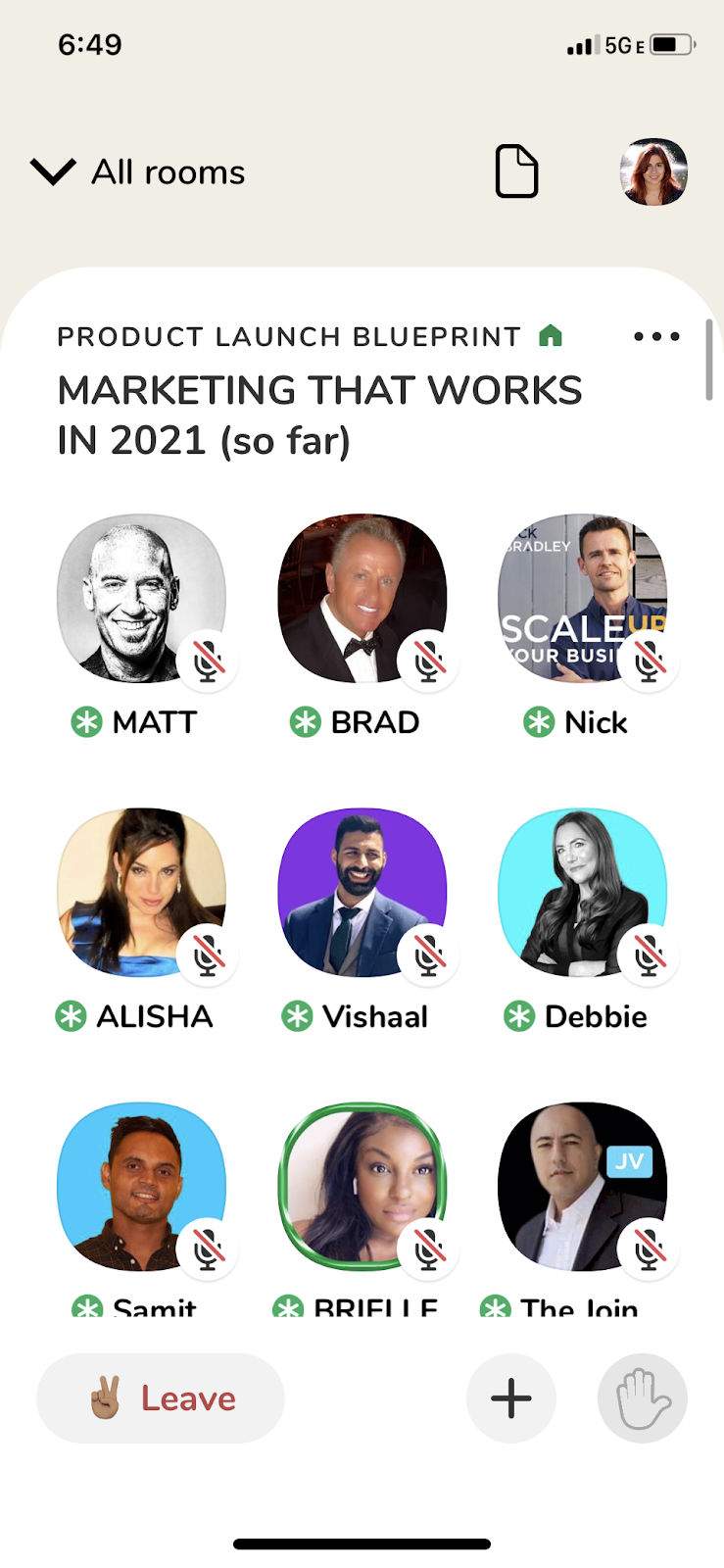
During the room, Cory Hughes, Vice President and Managing Partner of the tax preparation business, Tax Nation LLC, was chosen to speak. He mentioned his company by name and explained that they create marketing content based on “stories” and positive feedback from “happy customers.”
After Hughes made his point, a few other listeners chimed in to agree with how important his tip was.
Not only did Hughes offer valuable advice to participants, but he naturally mentioned his company and its happy customers without sounding like he was trying to plug his tax preparation product.
Start Scale Sail
In another room, titled “Scale Your Business With Digital Products,” entrepreneurs, marketers, and consultants shared tips for growing brands based on their experience,
For example, Natasha O’Banion, CEO of Start Scale Sail, a business automation and consulting firm, explained that she was a big fan of quiz content and added that her team’s successfully generated leads through interactive content.
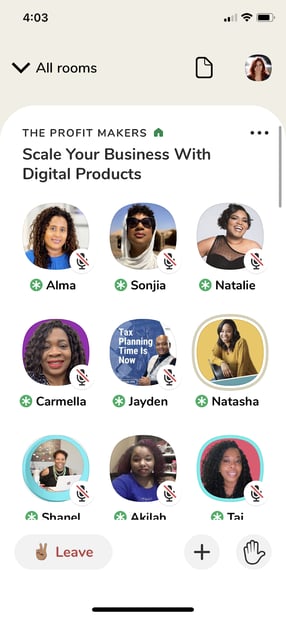
Although O’Banion didn’t plug her company by name, her explanation of how she’s used quizzes in her own strategy led to questions and more discussion from other attendees. Because she gave valuable input, listeners with similar interests in digital lead generation might be interested in following her or even learning more about her brand.
4. Hosting informal chats
Because Clubhouse is all about discussion and authenticity, many brands have also tried to show their human side and seem more accessible to audiences by hosting informal chats with no obvious goal or topic. This method is more casual, and potentially less intimidating, for listeners who might not raise their hand to speak in a fireside chat with a full agenda.
Below is one example:
DRK Beauty
One brand that hosts inviting, casual rooms is DRK Beauty, a website and commerce platform for people of color, which regularly publishes content around mental health, fashion, beauty, lifestyle, and culture.
At the end of each week, DRK’s team hosts “Weekly Wine Down” rooms aimed to feel like visiting a bar with colleagues or friends at the end of a long week.
While DRK rooms, often hosted by DRK Beauty CEO Wilma Mae Basta, don’t have a set topic or agenda, the team often introduces themselves as speakers, begins a casual conversation about whatever is on their minds, and allows other audience members to raise their hands and chime in at any time.
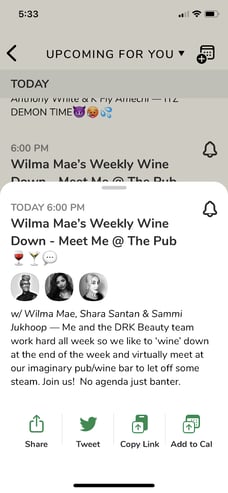
While DRK Beauty rooms aren’t usually aimed to promote the brand’s site, DRK still enables its audience and prospective web visitors to learn about the people behind the company in a casual, authentic setting. This makes the brand seem accessible, authentic, and trustworthy, three things social media users value when researching brands in 2021.
The key to Clubhouse? Be human.
It’s key to remember that Clubhouse is all about authentic human connection, not branding or self-promotion.
While Clubhouse began as a platform where users could only hear from industry “elites,” the app’s now open to a wide range of creatives and every-day people who want to communicate or interact with others. Because of this, learning about a brand is likely not the first thing a user wants to do when logging on to the app.
Regardless of which strategy you use on Clubhouse, remember to embrace the human side of the app. For example, rather than hosting a room where you explain your brand or products to audiences, consider hosting a fireside chat with a thought leader in your industry or participate in a room that allows you to discuss your industry with others in it.
While focusing on natural conversation and valuable room participation won’t enable you to outright market your product all the time, leaning into the platform’s conversational and personal nature could help you grow a following that trusts your expertise — and eventually — your brand.
Want to learn more about the latest social media marketing trends? Check out the free resource below.
![]()
![Download Now: Social Media Trends in 2021 [Free Report]](https://no-cache.hubspot.com/cta/default/53/3dc1dfd9-2cb4-4498-8c57-19dbb5671820.png)
